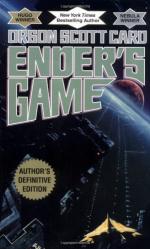|
|
Ender's Game Objects/Places
Monitor: A device implanted directly to a person’s brain at a very young age, which allows government officials to determine if these children are capable of being the future leaders in the military. It is connected to the brainstem and allows the government to monitor the events of the child, both inside their minds and out.
Desk: A portable computerized workspace. It is best described as a wirelessly-connected tablet computer. Someone can have access to information without wires, and also use the desk as a notebook to write and doodle upon. There is the capability of browsing the "nets," getting mail, and playing games as well. Desks are very common and not very valuable in this future.
Third: A third child in a family. In this security-state future, every pair of parents is allowed only two children. Presumably, the government also created a taboo out of the notion of a third child. Ender, however, was a "waiver," because excellence was noted in his family, and was looking for the perfect set of traits for a military leader.
Nets: Card invented an ambiguous notion about interconnected computers that look like networks, and called it "the nets." It is strikingly similar to the modern-day internet, and appears to be the medium that has completely replaced print. The anonymity provided by the nets (parallel to the real-world’s internet) was critical to Peter and Valentine’s own plan.
Battle School: A wheel-shaped station in the Asteroid Belt, where exceptional youth are taught the basics of military and academic disciplines. The central feature of this school is a game which occurs in the "Battle Room."
Game Room: A room like an arcade where students, during free time, can play games alone or against each other. This is all geared towards their military training, so the games appear to be mostly strategy games.
Battleroom: A place where battles occur between teams of youth under the command of one, in zero-gravity (called nullo by the children). This is a large cube-shaped room with doors placed in the middle of two opposite walls. There are, apparently nine rooms which the teachers can change the configuration of, and add floating large objects, called "stars," by the students. Students learn three-dimensional strategy and how to command (or follow command) in the battleroom in a glorified game of laser tag.
Flash suits: Plastic suits for use in the Battle Room. These suits indicate whether someone has been hit, and completely stiffen (or freeze) upon being hit. Someone can be damaged (hit in a place that does not remove their ability to fight), disabled (damaged in a way that makes them harmless), or frozen (completely stiff from head to toe).
Fantasy Game: A game one can play on his/her desk in which the player has to solve situational puzzles. The game adapts and changes to what the player does. It is called the "mind game" by the adults when they are alone, and as such is intended to interact with the student to analyze and shape his/her psyche.
Armies: Armies are the main social unit in Battle School. They function like sports teams — they live, practice, and fight together. There are forty members of the army, plus a commander.
Toons: In every army, a Commander assigns leaders of smaller units called toons. They usually consist of ten soldiers, though they not always do.
Deadline: A very strong and very thin wire used to hold objects together during construction in space. Bean innovated its use in the battleroom.
Ansible: Term for a method of instant (and therefore faster-than-light) communication over huge distances. It is by this technological method that the human invasion fleet communicates with Earth. The Buggers use a biological analogue of the ansible (dependent on the same physical properties) to communicate across light-years instantly.
Dr. Device: The M.D. Device (called Doctor Device or Little Doctor for slang) stands for "Molecular Disruption" Device, and it is a weapon that makes it impossible for any two atoms to coexist in a molecule. Use of this weapon creates a field in which this physical property is the case, and the result is total destruction of the object. It is the ultimate weapon to use against the buggers.




